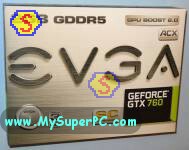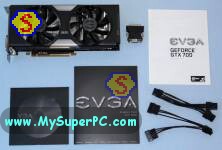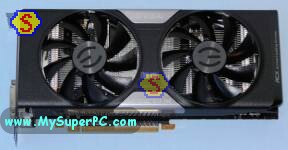Video Card
The four key components of overall system performance are the
motherboard, processor, RAM and the video card. As good as the video
cards of today are, they can still be the bottleneck when used with
high-end processors and RAM. Computers designed with graphics
capabilities in mind need a high end video card much more than a high
end processor. The video card I have is the GeForce GTX 760, a PCI Express 2.0/3.0 x16 video card.

|

|

|
Click on any picture to see it enlarged.
|
How To Buy The Right Video Card
There's quite a battle raging between the top and only two video card
makers, NVIDIA and ATI. Like the contest between the AMD and Pentium
processors, both offer select products that would help make an excellent
computer. Ultimately, we consumers will benefit as they race to add
performance and features while cutting costs. Go to it guys! You as PC
builder just need to make sure you get one of the better models and one
that's right for you, and I can help with that.
What's happening is that these two titans of video cards, ATI and
NVIDIA, are in an aggressive, money-is-no-object (for you) struggle to
claim "fastest video card in the world". But the reality is that even
dedicated PC enthusiasts wince at a price point over $300 for a video
card, and those less enthusiastic are looking to spend considerably less
than that. Well, that's ok, in fact that's good. Historically it hasn't
taken long for the highly touted video cards to come rapidly down to
earth in price to clear the decks for the latest-even-better video card.
The video card slot type of today is PCI Express x16. The video card will be identified as a PCI-E video card. In fact, PCI-E is currently available in two versions, version 1.0 or version 2.0. Older video cards can be of type AGP. PCI-E 2.0 has greater raw bandwidth than PCI-E 1.0. In fact, double the bandwidth. But, in practical terms, this extra performance is only realized in very demanding graphical situations (think top-tier games played at 1600x1200 resolution, things like that) and even then will be no more than a 20 percent improvement. The video card and motherboard must be of compatible slot types, meaning both PCI Express x16. To reach the full potential of PCI-E 2.0, both the motherboard and video card must support PCI-E 2.0. Different PCI-E versions of the motherboard and video card can be used together, they will just run at the version 1.0 speed.
You may see a video card model described as a DirectX 10 model or a
DirectX 10.1 model or DirectX what-have-you model. I don't consider this
a compelling factor in which high-end video card to purchase. All the video cards
will support all the DirectX features, some just do more in hardware
than others, but all the high-end video cards are powerful enough to get
the job done.
Another feature that tends to distinguish high-end video cards from one
another is whether or not they support AA (antialiasing) in hardware.
Those that do support it in hardware perform much better on AA
benchmarks than those that do not. Again, I don't consider this a factor
in which high-end video card to purchase. AA is a process whereby jagged
edges are made a bit smoother. It's a somewhat subtle effect. It's not
worth a lot of dollars, in my opinion. A feature that's similar in
these respects is AF (anisotropic filtering) which enhances the quality
of surfaces that recede away from the viewer.
Many video cards, especially high-end video cards, are so
physically large that they take up two card slots, the video card slot and the adjacent slot due to the large coolers often needed for very powerful video cards.
Although this may appear to be extreme and
undesirable, it's not as big a negative as it might at first seem since
modern motherboards now come with features built-into the motherboard
itself that previously required an add-on card. Most motherboards
come with 5 extra add-on card slots or more and it's highly unlikely any computer
would use them all.
NVIDIA video cards usually support SLI (Scaleable Link Interface).
SLI allows two video cards to run together in the same computer to
increase performance. For SLI to be used, the video cards and that the
motherboard must both support SLI. However, SLI has yet to become an attractive option since a non-SLI motherboard and a single high-end video card delivers more for less money than an SLI-motherboard and two SLI compatible video cards.
The ATI counterpart to SLI is called CrossFire. Like SLI, the video cards and motherboard must both support Crossfire. ATI also supports CrossFireX, which allows three or four video cards to be used together. Under a CrossFireX configuration with 4 video cards, it's possible to have 8 monitors in use.
Make sure that the video card has the right input and output connectors for your configuration.
A DVI-I connector is typically used to connect to a flat panel display monitor (FPD).
Those into video editing may want a video card with
an S-video output connector. And if you want a dual monitor system then check that the video card has two DVI-I connectors.
As video cards have become more powerful, they have become more power
hungry. It's not unusual for a high-end video card to have a power
connection directly from the power supply. Usually this is a PCI-E 6-pin power connector. However it could be a PCI-E 8-pin power connector. And it's possible the video card could require two power connectors, such as two PCI-E 6-pin power connectors. If the video card requires more than one PCI-E 6-pin power connector then make sure the power supply that will be used has enough of the right kind of PCI-E power connectors.
The video card will have a minimum recommended power supply wattage. This can vary from model to model, and even from make to make of the same model. The video card minimum recommendation assumes it is being used in a typically configured computer. I tend to configure my computers on the demanding side, toward the high-end of performance, and I've never had a problem with sufficient power as long as I used a quality power supply (Antec and Enermax brand power supplies are my favorites), and used a power supply with wattage that met or exceeded the minimum recommendation for the video card. Computers running two video cards configured in SLI or CrossFire will need a substantially beefier power supply than a computer running a single video card of the same make and model.
Great power increases the chances of great noise. This is due to the
amount of heat that is often generated with the more powerful components
which require more powerful fans to keep them cool. But in many instances even powerful video cards do not generate an unexpected or unacceptable amount of noise, so make sure the model you choose is right for you.
Whether ATI or NVIDIA, the same video card model can be made by more
than one manufacturer (different "makes"), such as Chaintech or Gainward
and many others. So what's the difference? Well beyond the core
architecture of the video card there could be lots of differences, such
as the length of the warranty, possible upgrade or step-up programs such as the eVGA Step-Up Program, the number and type of input/output connectors provided on the video
card, the cooling mechanisms built into the video card, and the type of software bundled (games, video editing) with the
video card. The quality of the components that make up the video card
could be different. My own preferred makes of video cards include ATI,
Chaintech, Gainward, Gigabyte, eVGA, ABIT and ASUS, but as you can see from the My Super PC graduates nearly
every make is represented.
The same model made by two different manufacturers should have the same specifications in regards to the video card processor and memory. It's possible for a manufacturer to make their own special modification to the specifications of a video card. For example, Gainward has made a number of models using faster memory on the video card and then added their own special designation of "Golden Sample" to the video card model to identify it.
Many models are available in variations that are identified by a designation following the model number, such as "SE", "LE", "Ultra", "XT" or "Pro". Don't make any assumptions about the performance of a video card based simply on its designation.
Be aware that to get the most out of a high-end video card you should
have a high-end processor and fast system memory to go with it,
otherwise the processor will not be able to keep the video card busy
under load.
Best Video Card Choice
It's not uncommon for the video card to be the most frequently upgraded
component on a gamer's computer. Prices fall so rapidly and technology
improves so quickly that today's outrageously priced video card soon
become too good to resist.
Here's a valuable piece of information to understand how much video card
is needed for a particular game - the minimum video card to reach
playable levels is one that provides a sustained rate of at least 30 frames-per-second
(FPS). Keep in mind that all games are different and some require much
less in a video card than others to reach 30 FPS, even at identical
configurations. Above this performance level will allow gameplay at
greater resolutions and greater color depth with fewer instances and
lesser severity of gameplay stuttering.






